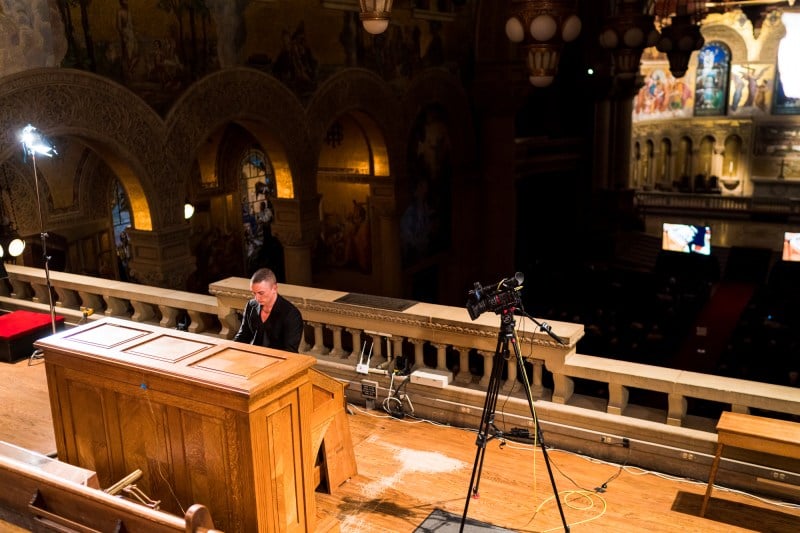I often pride myself on the wide range of music, genres and artists I listen to. Before I entered Memorial Church on March 31, however, I had never once listened to, or attended, an organ performance. Fortunately, I was ushered into the world of organ music by Grammy-nominated organist Cameron Carpenter, a seasoned and well-respected professional in the field.
Despite its diverse range of sounds, Carpenter was able to utilize this unique instrument with skillful expertise. He masterfully transported his audience to the 17th and 18th centuries as he played excerpts of Bach that resonated through Memorial Church’s dimly lit interior of golden mosaics and high-lofted ceilings.
Playing interpretations of Bach’s Goldberg Variations, among other works from Bach’s canon, Carpenter performed for nearly two hours. Carpenter’s renditions of Bach are hard to explain — or, perhaps, it’s the instrument itself, which seems complicated to deconstruct. For those unfamiliar, it perhaps initially comes as a surprise to learn that some organs have multiple keyboards (called manuals) — the one at Memorial Church has four and additionally has a pedalboard manipulated by Carpenter’s feet used to control the bass pipes. Unlike a piano’s keyboard, which uses small hammers to hit strings, the organ’s manuals are connected to a set of windpipes that usher pressurized air through to produce noise.
The organ, at times, sounds like an amalgam of multiple instruments all playing at once. Sometimes, it sounds like a muddled piano that doesn’t quite know what to do with itself, plus two extra manuals. Other times, the organ more closely resembles an electronic keyboard in sound, with hints of a woodwind timbre.
As Carpenter’s fingers expertly and effortlessly scaled three gradations of keyboards, often playing two manuals simultaneously to create a distinct texture, the organ sounded like fluttering fairies in flight.
Carpenter’s interpretation of the Goldberg Variations captured a myriad of sounds, sometimes sounding like a ballroom waltz or at other times a wedding procession, while also playing more solemn songs, thereby showcasing his wide range of versatility.
Fluctuating frequently from somber tones and slow paces to quick fortissimo notes, Carpenter commanded impressive pedal work that shook Memorial Church with a profound bass, showing his mastery of this instrument.
Organ music may not appeal to everyone, and that’s perfectly okay. I was personally fascinated by his quick-moving fingers, dexterity and coordination. My untrained ear, however, couldn’t discern much between the various pieces he played. And I confess, the pieces all began to sound very similar after hours of listening. Nevertheless, everyone experiences music differently, and I certainly saw rows of audience members in the pews of Memorial Church mesmerized by the way Carpenter played.
Because of the way the instrument is positioned within Memorial Church, the audience had to watch through two large screens located at the front of the church as Carpenter, himself, played behind all of his onlookers on top of the organ balcony.
This setup of the organ balcony being situated behind the audience didn’t feel the most conducive to engaging the audience — although that is how most churches are constructed. Even after watching the performance for nearly two hours, I had yet to see Carpenter’s face, which I felt took something away from the performance. The screen captured only Carpenter and the organ from the neck down, removing much of the intimacy and experience that comes from observing the artist’s expressions as they pour their heart and soul into the pieces they are performing.
Despite the foregoing, Carpenter still expressed a wealth of emotions through the dynamic pieces he played that captivated the audience. While I will likely not be frequenting any more organ performances in the near future, Carpenter’s performance was an amazing experience that left me awed by his coordination and the grace with which he adeptly played this beautiful instrument and the famed Goldberg Variations.
Editor’s Note: This article is a review and includes subjective opinions, thoughts and critiques.
